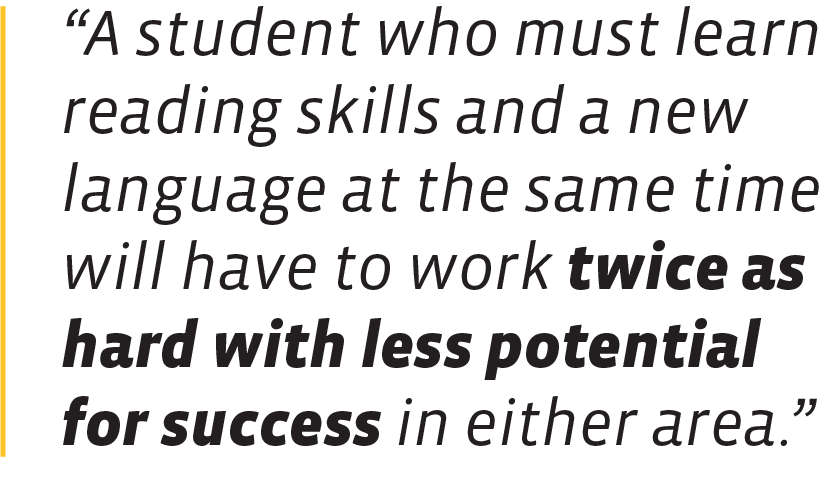 Millions of K-12 students across the United States are English Learners (ELs). The majority of these students identify Spanish as their home language. Year after year, the National Assessment of Educational Progress (NAEP) Average Scores for Reading and Mathematics are significantly lower for students who are identified as ELs, in comparison to their peers who are not. It makes sense that limited English proficiency would have an impact on academic achievement where the language of instruction is English. So, what can we do to best support EL students?
Millions of K-12 students across the United States are English Learners (ELs). The majority of these students identify Spanish as their home language. Year after year, the National Assessment of Educational Progress (NAEP) Average Scores for Reading and Mathematics are significantly lower for students who are identified as ELs, in comparison to their peers who are not. It makes sense that limited English proficiency would have an impact on academic achievement where the language of instruction is English. So, what can we do to best support EL students?
Oftentimes home languages are actively repressed in favor of the target language (English). Yet, we ought to take advantage of the language skills that a student does have. Home language literacy serves as a foundation for literacy in an additional language. A student should learn and practice reading skills first in the language that they are stronger in. Then they can build upon those strengths in a new language.
Home-language literacy helps, and does not hinder, reading development in a new language.
While grammar rules, letter sounds, and other factors differ between languages, the foundational reading skills developed in a student’s first language will transfer to the second language. A student who achieves reading proficiency first in their home language is better prepared to take on reading development in a new language. Conversely, a student who must learn reading skills and a new language at the same time will have to work twice as hard with less potential for success in either area (Short & Fitzsimmons, 2007). If the goal is for the student to be able to read in English more quickly and easily, the first step is literacy achievement in the home language.
Research also shows that students do have the capacity to learn multiple languages at once without jeopardizing either language (Genesee & Lindholm-Leary, 2021). A student’s progress in English will not be hindered by time spent developing home language skills.
Effects of home-language neglect
In pursuance of English proficiency, sometimes parents of ELs are encouraged to only speak English with their children. While this concept may be well-intended, it can harm students. An English-only approach can be very limiting for effective communication between parents and children. Additionally, other family and community members may not be able to fully participate in the child’s growth; it will be more difficult for them to share stories and traditions, communicate, or even support the child's schoolwork.
Home language neglect can be detrimental for a student in terms of self-concept, relationships, and overall language development. Parents should be encouraged to use their home language with their children to foster a richer and more natural language experience. Furthermore, efforts should be made to support home language development within schools.
Benefits of multilingualism
 Research shows that multilingualism has educational, cognitive, economic, and sociocultural benefits. Multilingualism can improve communication skills, creativity, problem-solving, and intellectual flexibility (Okal, B. O., 2014). It also fosters greater empathy development and global awareness. Not to mention, language skills serve as a ticket to greater job opportunities and earning potential. Encouraging home language use also has a positive impact on the learner’s self-concept. Understanding that their home language has value may help students develop a sense of pride and a healthier self-identity.
Research shows that multilingualism has educational, cognitive, economic, and sociocultural benefits. Multilingualism can improve communication skills, creativity, problem-solving, and intellectual flexibility (Okal, B. O., 2014). It also fosters greater empathy development and global awareness. Not to mention, language skills serve as a ticket to greater job opportunities and earning potential. Encouraging home language use also has a positive impact on the learner’s self-concept. Understanding that their home language has value may help students develop a sense of pride and a healthier self-identity.
Read Naturally Live—Español
English Learners that identify Spanish as their home language can build fluency, reading skills, vocabulary, and comprehension in our web-based literacy program, Read Naturally Live—Español. It is a mostly independent reading program with nonfiction story text, quiz questions, directions, and button labels all presented in Spanish. The program may be used with Spanish-speaking students before or while a student learns to read in English. The program also helps native English speakers or others to learn to read Spanish text fluently as an additional language.
Note: For Spanish-speaking students using our English-fluency program, Read Naturally Live, there is a Spanish read along included that will help them build the context needed to understand the story before reading it in English.
Sources:
Genesee, F., & Lindholm-Leary, K. (2021). The suitability of dual language education for diverse students. Journal of Immersion and Content-Based Language Education, 9(2), 164–192. Portico. https://doi.org/10.1075/jicb.21001.gen
Okal, B. O. (2014). Benefits of multilingualism in education. Universal Journal of Educational Research, 2(3), 223-229.
Short, D., & Fitzsimmons, S. (2007). Double the work: Challenges and solutions to acquiring language and academic literacy for adolescent English language learners – A report to Carnegie Corporation of New York. Washington, DC: Alliance for Excellent Education.
Other Recommended Reads:
Why Reading to Your Kids in Your Home Language Will Help Them Become Better Readers
The Home Language: An English Language Learner's Most Valuable Resource
Response: ELL Students’ Home Language Is an Asset, Not a ‘Barrier’

 Share your student’s success story—nominate him or her for our Star of the Month award. Win a Barnes & Noble gift card for the student and a Read Naturally gift certificate for your class!
Share your student’s success story—nominate him or her for our Star of the Month award. Win a Barnes & Noble gift card for the student and a Read Naturally gift certificate for your class!
Post a New Comment